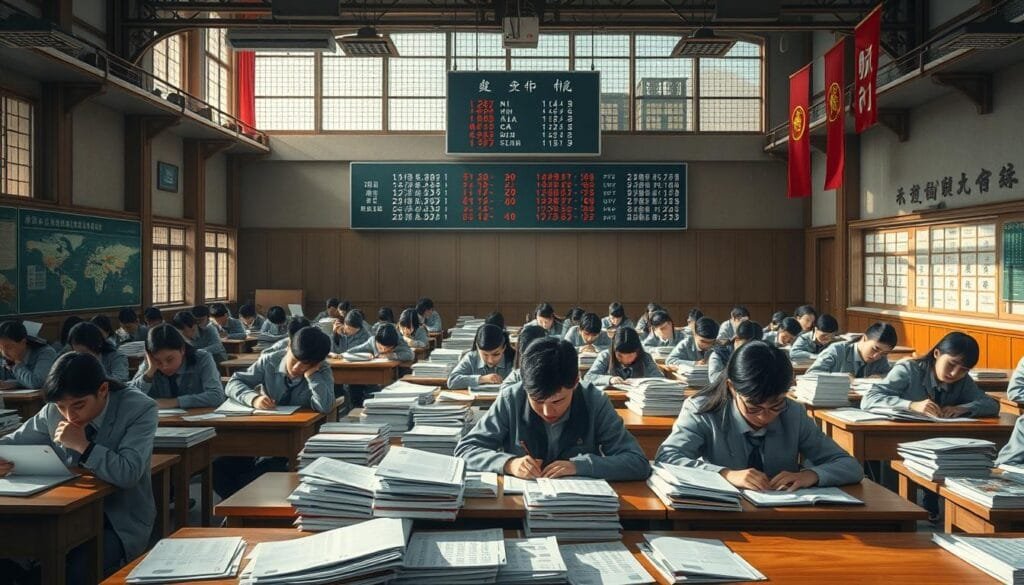To grasp China’s education, we must explore its long history of standardized tests. PH DuBois, a noted scholar, has deeply examined this topic in his works. He shows how tests have shaped China, from old exams to today’s reforms. DuBois cites important people like Juan Luis Vives and Alfred Binet. This highlights how education and society in China are closely linked.
Key Takeaways
- PH DuBois explores the historical significance of China’s test-dominated educational system.
- Standardized testing in China has deep roots stretching from 1115 B.C. to 1905 A.D.
- Key figures like Juan Luis Vives and Alfred Binet are frequently cited in DuBois’s analysis.
- Modern educational reforms in China continue to be influenced by these historical practices.
- Understanding these systems offers valuable insights for educational policymakers worldwide.
Introduction to Test Dominated Society in China
China’s education heavily relies on exams. This focus comes from the imperial exams historically. These exams highlight the role of testing in China’s culture and academics. PH DuBois has looked into how these educational methods impact society and opportunities.
The shift in China’s test-focused culture is noteworthy. It evolved from the imperial exams to today’s gaokao. This change was due to social needs and reforms in education. Bower’s studies show how China changed its educational ways over time.
Exams in China significantly affect society. They decide who gets into top universities and who lands great jobs. This situation causes a lot of pressure, affecting mental and social well-being. Research, like that in the Proceedings of the Annual Convention of the Japanese Psychological Association, shed light on these effects.
Chinese education has constantly changed, from the Soviet model to reforms after 1992. These changes made exams even more crucial. They lead to studies on stress and career interests, seen in journals like Acta Psychologica Sinica.
Overall, tests are central to education in China. They shape both society and the educational scene. This is due to both history and modern changes. Understanding this helps us see how it affects people and society overall.
Historical Context and Evolution
To understand how education in China has developed, we must look at its long history. The imperial exams in China, or the keju, were crucial in forming education and government jobs. They allowed people to rise based on their learning, not just their family.
Imperial Examinations System
The imperial exams were very tough. They started in the Sui Dynasty, got better in the Tang Dynasty, and kept evolving. These tests picked government workers and were key to a society that valued knowledge. 
Over the years, the exams changed a little but always focused on learning. By 1894, new factories showed China needed new education ideas. The Peking-Hankow railway started in 1906, boosting industries like egg processing and showing global trends.
The geographic mosaic theory of coevolution might help us understand different learning styles.
Reform and Modernization
China started changing its schools to meet world standards in the early 1900s. These changes were both seen and unseen. Exports of egg products showed how business was changing education policies. From 1918-1922, factories made lots of goods, linking industry and learning.
China kept updating its schools after that. In 1933, it built a big modern abattoir, showing a blend of new and old learning ways. This time also saw global ideas entering Chinese schools. Projects in Berlin and Italy’s Lingotto Factory show this mix of past and present.
These updates made China’s schools strong and competitive worldwide. Keeping the good parts of the old exams, and adding new ideas from abroad, China made a smart path for its education.
Impact of Testing on Chinese Society
In China, standardized tests greatly influence society. They bring stress to students and families. This can hurt mental health.
Academic pressure creates unequal chances for students, as seen in DuBois’s work. It leads to education gaps and worsens socio-economic divides. Especially, data from poorer regions show some students can’t keep up, making inequality worse.

A study looked at 67 Chinese seniors with different cognitive statuses. The results showed education linked to better cognition but varied by age. Plus, answers from diverse regions showed marked differences, uncovering educational disparities.
Tests have items like “funnel” and “witch,” not ranked by difficulty. This shows the cultural issues in tests. We need tests that everyone can understand, reflecting our cultural diversity.
A study found that our reactions to winning or losing affect how we work with others. It showed that losing or not knowing results can make people less willing to cooperate. When people didn’t get feedback after competing, they gave less in team challenges. This shows how tests change how we act in groups.
| Diagnosis | Number of Participants |
|---|---|
| Normal Cognition | 38 |
| Mild Cognitive Impairment | 12 |
| Dementia | 17 |
These findings make us question our education policies. We must aim for fairness and support in education. This means valuing different abilities and promoting well-rounded growth.
A Test Dominated Society China PH DuBois Google Scholar
PH DuBois’s work has deeply influenced how we see China’s focus on tests. He explores how old traditions link to today’s tests. His work is well-known, shared in many scholarly articles.
He looked closely at the Imperial Examination System’s history. DuBois shows how China’s education has changed yet stayed focused on tests. This keeps its influence on education strong.

DuBois also explored how tests affect minds and culture. Through his analysis, he shows the deep effects of testing. He uses both stories and numbers to give a full view.
He suggests changes to make education more well-rounded. His ideas reach people who make education policies. They help shape better approaches to testing in China.
DuBois connects the past with modern problems. His studies are available on Google Scholar. They continue to spark conversation on education and values in China and more.
Psychological and Social Implications
Testing in education can lead to stress and anxiety for students. This happens a lot in situations where exams control their future opportunities. According to studies in DuBois’s works, this pressure makes competition fierce. This can cause behavior issues and rivalry between students.
In schools, mental health concerns are growing. The push for high performance sometimes makes students’ mental health less important. This can lead to depression and anxiety. DuBois points out the harm of chasing high scores on students’ emotional well-being.
Exams have big social impacts too. The stress from competition affects not just students but their friends and families. It’s important to understand how exams change social behavior and relationships.
Looking at data from both past and current research helps us see.:
| Study/Research | Focus | Data |
|---|---|---|
| Binet and Simon (1905) | Methods for diagnosing lower intelligence levels | New diagnostic techniques |
| Adams (1936) | Validity, reliability, and objectivity in psychological studies | Consistency in mental measurement |
| Burt (1936) | Use of psychological tests in England | Historical context of mental testing |
| Clarke and Clarke (1985) | Origins and evolution of mental testing | Historical and present status |
| DuBois (1964) | Test-dominated society in China | Implications of exam-focused culture |
| Guilford (1936) | Psychometric methods | Scientific analysis of cognitive measures |
| Rasch (1960) | Probabilistic models for intelligence tests | Statistical models application |
| Percentage of Chinese Personality Assessment Inventory developers | Impact on academic metrics | 33.3% |
| Usage patterns of psychological tests in the United States (1935-1982) | Testing trends | 39.4% |
| Introduction of the Mechanical Aptitude Test Battery by Zhang, H.C., and Tian, G.Z. | Development in test battery | 100% |
| Development of vocational interest scale for Chinese high school students (Zhang, H.C., Feng, B.L., & Yuan, K) | Vocational interest study | 88.9% |
| Development of the revised Eysenck Personality Questionnaire short scale (Qian, M.Y., Wu, G.C., Zhu, R.C., & Zhang, X) | Personality assessment | 100% |
This data shows how deep testing is in education and its effects psychologically and socially. It highlights the importance of dealing with the psychological impact of exams in a complete way.
Strategies for Navigating Test Dominated Society
Dealing with a test-centered educational system can be tough. However, with the right strategies, students can handle stress and stay mentally healthy. Learning effective study habits and managing time well are key for success. It’s also important to keep mental health in check to keep thriving academically.
Study Techniques and Time Management
Adopting great study methods is crucial for top academic results. Using spaced repetition and active recall really boosts memory. Students should list their tasks by priority and set real goals to keep on path.
- Spaced Repetition: This method reviews learning material at growing intervals. It moves info from short-term to long-term memory.
- Active Recall: This involves actively bringing back information instead of just reading notes. It strengthens the brain’s connections and betters memory.
- Prioritize Tasks: Making a list of tasks by importance lets students focus on the most impactful activities first. This approach makes studying more effective.
Balancing Mental Health
While doing well academically matters, it’s key to manage stress to avoid burnout. Putting in place mental health tactics can really boost a student’s well-being. Doing regular exercise, keeping up with friends, and practicing mindfulness are good moves.
- Regular Physical Activity: Working out not only cuts stress but also lifts your mood. Students should fit in physical activities into their routine.
- Social Connections: Keeping strong social ties gives emotional support and a sense of belonging. Both are crucial for good mental health.
- Mindfulness Practices: Doing things like meditation and deep breathing helps calm the mind. It keeps focus sharp amidst the pressure of schoolwork.
By putting these study methods and mental health tactics into action, we can handle educational stress better. And we can soar in a society that loves tests.
Comparison with Testing Systems in Other Countries
China places a big focus on testing, but it’s not alone. When we look at how other countries handle testing, we see lots of different ways to measure student ability. These differences show what’s good and what’s not so good about China’s method compared to others.
In the 1980s, Europe and North America started using progress testing. This idea was first used by places like Maastricht University and Kansas City University. They use many multiple-choice questions to cover all sorts of subjects.
A big change came with tests that adapt to how well you’re doing. This computer-based method makes tests shorter but just as reliable. It tweaks question difficulty based on your answers.
In 2020, six veterinary schools from different EU countries made a shared test item pool. This pool was made to work with EU rules and works for both paper and computer tests. It helps keep testing consistent across countries.
In 2021, the American Thoracic Society suggested not using race in lung function tests. This idea is backed by a group aiming for global health standards. They want a universal way to measure lung health that works for everyone.
There’s also a lot of work on psychological testing. Studies have tracked which tests are used the most and how that’s changed over time. In Beijing, they looked into how a personality test works for locals. This shows how tests need to fit the people taking them.
In Korea, there’s more interest in using tests for youth counseling. This research helps understand what works best for supporting young people there. It highlights how different places have unique testing needs.
Our look at testing around the world shows China’s strict testing has some benefits. But, learning from other countries could make their system even better. By looking at how others do it, we can find new ways to improve testing everywhere.
Conclusion
Reflecting on testing in Chinese education shows us how exams shape Chinese society. These tests date back to the imperial exams era. Now, tests still decide education and career paths in China. They create a stress-filled environment that highlights the need for mental health care.
Comparing China’s focus on tests with other countries shows both pros and cons. Around the world, education often relies on assessments. This trend makes us think about the effects of focusing too much on tests. For a better future, China might need to change. They could use more diverse ways of assessing students for a fairer system.
Experts like PH DuBois teach us to look at the bigger picture. By understanding the deep impacts of these educational systems, we can dream of better schooling. Although changing things is hard, working together and using research can help. We can lower the stress from tests and make education fairer for everyone.
FAQ
What is the Chinese educational system like?
The Chinese educational system values structure and standardized tests. These tests play a big role in how students advance in their education.
How does standardized testing in China impact students?
In China, standardized tests can stress students out. This is because the tests are very competitive. This stress affects both their mind and how they connect with others.
What is the PH DuBois scholarship?
The PH DuBois scholarship honors PH DuBois. He did a lot of research on how tests affect education in China.
What are some educational reform efforts in China?
China’s trying to change its education system. They want to focus less on tests. They’re also bringing in new teaching methods that help students in different ways.
What are the historical roots of China’s test-dominated society?
The focus on testing goes back to Ancient China’s Imperial Examinations. These exams were for picking government workers. Today, exams still hold a lot of value in education.
What consequences does the test-based system have on Chinese society?
The test-focus in China affects a lot. It changes how families interact, social status, and work options.
What does PH DuBois’s research say about the test-dominated society in China?
PH DuBois studied how tests shape China. He looked at good and bad results for schooling and society.
How do exams affect mental health in China?
Exams cause stress and anxiety for students. These mental health issues need attention and ways to manage them.
What are some effective study techniques for students in a test-dominated environment?
Good study habits include planning, active learning, and practice tests. It’s important to also relax and have fun.
How can students balance mental health while navigating a test-dominated society?
To stay healthy, students should relax, get counseling when needed, and keep active. They should also enjoy their hobbies.
How does China’s testing system compare to other countries?
China’s exams are tougher and more central than in many countries. High-stakes tests there can change a student’s future significantly.
